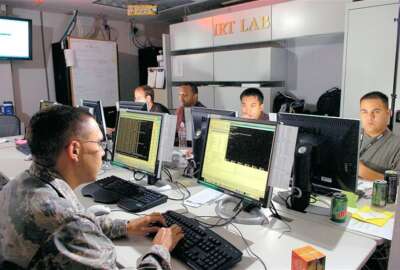DoD IT agency gets chief data office to help shift toward automated cybersecurity
The CDO office is less than a year old, but DISA officials want to put data at the center of everything the agency does going forward.
The Defense Information Systems Agency has a new chief data officer organization to help the IT-focused agency getter better use out of its data, especially to help automate security against proliferating cyber attacks on military networks.
The office of the CDO is about seven months old, with 20 civilian and contractor personnel split between its two branches focused data management and knowledge management, respectively, according to Caroline Kuharske, DISA’s deputy chief data officer. DISA has yet to hire a permanent chief to lead the new office.
DISA is still in the “infancy” of identifying where data is and standardizing legacy data with newer information, according to Kuharske.
“Long story short, we’re still in discovery mode of where everything is,” she said during an address at AFCEA’s TechNet conference in Baltimore, MD, last week.
But the imperative to use data as a “strategic asset” is spelled out in DISA’s latest strategic plan. The CDO’s office is expected to drive DISA “toward a more data-centric culture and ensure that data is discoverable, accessible and decision-enabling through secure and modernized systems, standards and governance,” the plan states.
“That’s really what my office is going to really start pushing for, is that data sharing and that data access across the board,” Kuharske said.
Another big thrust behind establishing the office is using artificial intelligence and machine learning to help defend DoD networks. DISA’s strategic plan calls for deploying automation “for proactive sensing of the command-and-control environment to drive incident avoidance, rapid response and increased operational agility.”
The new office will help catalog data sources to allow “visibility of the attacks as they’re actually occurring on the network,” Roger Greenwell, DISA’s chief risk officer and chief information officer, told reporters during a media roundtable at the TechNet conference
“The days of being able to do retrospective analysis, it just doesn’t work,” he said. “Recognizing how many endpoints that we have on the network and being able to have visibility of that. To sit here with a number of analysts and expect them to be able to do these things in a manual sense is just not possible. So AI and machine learning are absolutely critical to that.”
He said DISA is running pilot projects with the Pentagon’s Joint Artificial Intelligence Center to use AI for cybersecurity.
Kuharske said she wants to also move beyond cyber operations to start using data to help drive the agency’s decision-making and operations across the board, especially related to spending. DISA recently launched a clean-sheet budget review to ensure its spending plans are aligned to the agency’s latest priorities.
“We do have some cyber analytics that are doing wonderful things within the agency, but we need to be able to combine not just cyber, not just business, but all of it,” she said.
Copyright © 2024 Federal News Network. All rights reserved. This website is not intended for users located within the European Economic Area.
Follow @jdoubledayWFED







